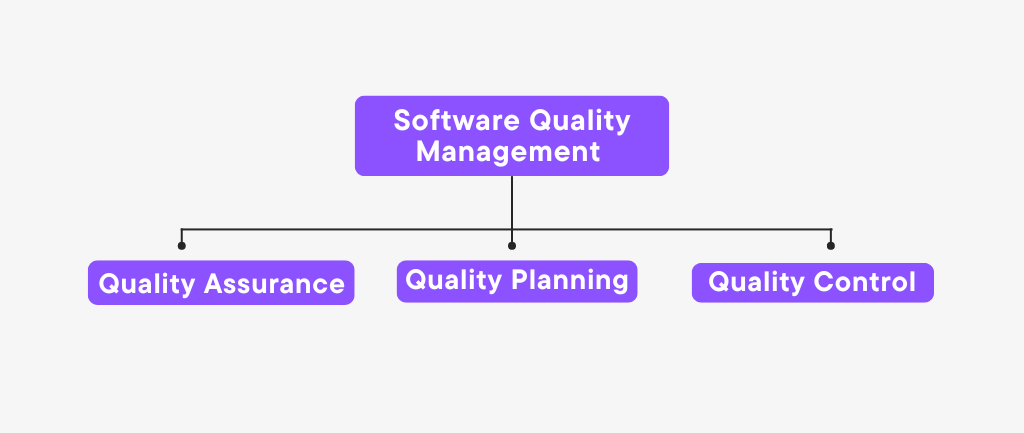In today’s digital era, software development holds unprecedented importance. The quality of software can significantly impact an organization’s reputation, success, and future trajectory. Ensuring high-quality software that meets client expectations is paramount. Factors such as thorough testing and effective debugging are critical considerations in the development process.
In this blog, we’ll explore key strategies to maintain premium quality throughout the software development lifecycle. Whether you’re a novice, seasoned developer, or a burgeoning software development firm, the insights shared here will prove invaluable in delivering superior software solutions and establishing a strong presence in the market.
Let’s delve into the intricacies of ensuring quality in software development!
Table of Contents
ToggleWhat constitutes software quality?
The quality of software hinges on its performance, exceeding user expectations, and meeting industry standards. Assessing software quality involves closely monitoring both code quality and testing processes.
Software Development Dublin Quality Management
Quality management in the software development dublin cycle can be understood as the process of guaranteeing that the software product that is so developed and deployed that caters to the requirements of the user or customer. It comprises certain activities and steps that aims to manage the equality of software product throughout the product development life cycle.
The goal of quality management in the software development process is to provide assurance that the software developed is highly functional, reliable and scalable, and above all user-friendly. It can be gained by applying a few combinations of tech practices, tools, and techniques along with quality testing, code reviews, and overall process enhancement.

- Planning: Planning of software quality consists of the analysis of functionality goals that define how the quality of the product will be.
- Assurance: This stage comprises meeting the needed quality standards at every step of software development process.
- Control: This includes taking and measuring the quality levels to make necessary improvements.
Significance of Quality Assurance in Software Development
Ensuring quality across the entire software product life cycle is essential. High-performing software not only boasts reliability and user-friendliness but also meets user expectations effectively.
Prioritizing quality throughout the software development journey enables early identification and resolution of issues, leading to significant time, energy, and cost savings. Additionally, robust software elevates the organization’s reputation and draws in potential customers.
Quality assurance plays a pivotal role in ensuring security by thwarting cyber threats and safeguarding against breaches. Compliance with quality standards is imperative, as non-compliance can result in legal and financial repercussions. Delve deeper to understand the importance of quality assurance in software development.
Customer Satisfaction: Software that offers a user-friendly experience is more likely to meet user expectations and enhance satisfaction.
Cost-effectiveness: Early detection and resolution of bugs during software development can save valuable resources, time, and money.
Reputation: Delivering high-quality software bolsters a company’s reputation and fosters popularity among users, whereas poor quality software can tarnish it.
Security: Providing software with robust security measures safeguards against a range of cyber threats, addressing a pressing concern in today’s digital landscape.
Compliance: Adhering to compliance standards and regulations during software development helps mitigate legal risks and potential penalties.
What constitutes the Software Development Lifecycle (SDLC)?
Just as every product has its own life cycle, software undergoes its unique Software Development Life Cycle (SDLC). With the escalating popularity of technological innovations, the demand for software solutions continues to rise. However, crafting robust and highly functional software remains a challenging task. Maintaining high quality is crucial at every phase of the software development Dublin process. To achieve this, following a systematic approach known as the Software Development Dublin Life Cycle is essential.
The software development Dublin Life Cycle consists of various phases and each phase has its own importance and potential risk.
Let’s explore:
Refer to the table:
PHASES |
PROCESS |
IMPORTANCE |
Risk
|
|
Planning |
The initial stage of the SDLC is planning. Here, all projected goals and objectives are defined, aiding in the formulation of strategies for subsequent execution and cost estimation. |
Thoughtfully planned objectives and execution processes are instrumental in achieving project success at a higher level. Clearly defined goals provide a suitable deadline and an accurate estimation of overall costs. | Disorganized planning lacking clear objectives can expose you to numerous risks throughout the software development journey. |
|
Requirements Gathering |
Gathering requirements stands as a pivotal stage in the SDLC. Every team member collaborates to collect essential data and analyze it thoroughly to craft enduring software solutions. |
Collecting necessary data promptly prior to project commencement facilitates achieving desired outcomes, ultimately delighting clients. |
Failure to gather accurate or comprehensive data will hinder the delivery of desired results. |
|
Design |
Once all information and details are gathered, the team initiates the design phase to outline the software and its functionalities. |
Thoroughly detailing the design outline guarantees the successful delivery of the software. |
Insufficient planning in design can lead to numerous issues and client dissatisfaction. |
|
Development |
This phase involves a meticulous development process where the software coding takes place. Coding stands out as the most time-consuming step in the entire SDLC. |
Correct and error-free coding guarantees the software’s sustainability and meets user expectations. | Regrettably, improper coding practices result in numerous bugs and errors, leading to a poor user experience. |
|
Testing |
During this stage, the team meticulously tests the software to verify its functionality and alignment with user specifications. |
The testing phase verifies the software’s proper functionality and alignment with user requirements. It also serves to uncover and address any issues before the software is deployed. | Lack of thorough testing practices fails to meet the client’s expectations. |
|
Deployment |
Deployment is the phase where the software is delivered to its intended destination. |
The successful delivery of the software confirms its readiness for use. |
Delivering software without proper testing leads to a subpar user experience. |
|
Maintenance |
Maintaining any software is vital and ongoing, ensuring that products remain updated and function efficiently. | Consistent enhancement and upkeep of any software guarantee its seamless operation. |
There are no potential risks. |
Also Read: Key Mobile App Development Challenges to Address in Dublin in 2024
Strategies for Ensuring Quality in Software Development
In today’s era, software development is a pivotal component for organizations striving to meet customer demands. It enables businesses to establish robust frameworks capable of addressing potential challenges and errors. However, ensuring high-quality software poses numerous challenges, making it a crucial aspect for any company.
Quality assurance plays a vital role in the software development life cycle by aiding organizations in identifying and resolving bugs and issues within the framework.
In the following discussion, we will explore several techniques for ensuring quality in software development.
- Test-Driven Development (TDD): It is a software development practice where tests are written before the code. Engineers define the expected behavior of a specific piece of code by writing a test. Subsequently, they write the code to pass the test. This approach ensures continuous testing, minimizing the likelihood of errors and bugs.
- Code Review: This method involves having multiple engineers examine the code before it is committed to the repository. Code reviews can be automated using various tools, or conducted manually by developers. The aim of a code review is to identify and reduce errors and bugs before the code is deployed.
- Automated Testing: These techniques include utilizing devices to test software consequently. Automated tests can be run persistently, guaranteeing that any mistakes or bugs are recognized at the earliest opportunity. This method likewise saves time and exertion as the tests can be run automatically.
- Cross-Device and Cross-Platform Testing:Testing across various devices and platforms ensures that applications are accessible to a broader audience and deliver a consistent user experience across all devices and platforms
- Refactoring: Refactoring involves modifying code without altering its functionality. This approach ensures that the code is optimized for performance and readability. Additionally, refactoring can help identify and eliminate errors and bugs in the code.
- Use of Design Patterns: This solution is reusable for basic software programming issues Utilizing design examples can assist with guaranteeing that the code is appropriately organized and simple to maintain and monitor. It can likewise assist with recognizing and wiping out blunders and bugs in the code.
- Utilizing Design Patterns:Design patterns provide reusable solutions for common software programming problems. Employing design patterns ensures that the code is properly structured, making it easier to maintain and manage. Additionally, it helps identify and eliminate errors and bugs in the code.
Instruments for Guaranteeing Quality in Software Development
Deploying high-quality software not only satisfies clients but also ensures the product functions as intended, free from bugs and technical errors. Fortunately, there are several tools available to developers that can help ensure quality throughout the product development lifecycle. Prior to hiring a Software Development Company, inquire about these powerful tools to safeguard your project in advance.
- Testing Frameworks and Tools: Testing is a vital aspect of software development, and various frameworks and tools are available to automate the Software Development Life Cycle (SDLC). Unit testing frameworks such as JUnit and NUnit enable engineers to test individual code components to ensure their expected functionality.
- Code Analysis and Static Code Scanning Tools: Code analysis tools aid in identifying issues in the code before they lead to errors. Static code scanning tools like SonarQube and Code Climate analyze code for issues such as code smells, duplicated code, and other common problems. These tools also provide recommendations on how to enhance code quality further.
- Continuous Integration and Deployment Tools: Continuous Integration (CI) and Continuous Deployment (CD) tools ensure that code changes are tested and deployed quickly and reliably. CI tools like Jenkins and Travis CI automate the build and testing process, running tests whenever new code is pushed to the repository.
- Project Management Tools: Project management tools like Jira and Trello help ensure that software development projects stay on track. These tools enable teams to manage tasks, track progress, and collaborate on projects. They also help ensure that deadlines are met and that everyone is working towards the same goal.
Obstacles to Achieving Quality in Software Development
Software development dublin is a complex endeavor fraught with numerous challenges in ensuring quality. Meeting client expectations hinges on the nature of the product, demanding a high level of expertise and attention to detail. Now, let’s delve into some of the challenges encountered in ensuring quality in the Software Development Lifecycle and explore strategies to overcome them.
Challenge: Gathering and Analyzing Requirements
One of the most significant challenges in software development is gathering and analyzing requirements effectively. Many projects suffer from incomplete or ambiguous requirements, leading to inadequate or ineffective software development. Therefore, it’s crucial to gather and analyze requirements carefully, involving all stakeholders in the process to ensure that everyone understands the expectations.
Solution: Software development companies employ various strategies such as client stories, use cases, and prototypes. These approaches help identify requirements and ensure they are clearly understood and agreed upon by all stakeholders.
Challenge: Ensuring Quality Assurance and Testing
Another challenge in developing high-quality software is quality assurance and testing. Testing is a crucial aspect of the development process, ensuring that the product functions as intended. However, testing can be a time-consuming and tedious process, and many software development teams struggle to balance the need for thorough testing with the requirement for timely delivery.
Solution: Software development companies can implement automated testing techniques and methods to reduce testing time and enhance testing accuracy. Additionally, they can adopt agile methodologies that emphasize continuous testing and feedback, enabling early detection and resolution of issues in the development cycle.
Challenge: Maintenance and Support
Software development extends beyond product deployment; it necessitates ongoing maintenance and support. Many projects suffer from inadequate maintenance and support, leading to prolonged downtime, decreased productivity, and escalated costs.
Solution:Software development companies can adopt a proactive approach to maintenance and post-launch support. This involves regularly monitoring the product and addressing issues as they arise. Additionally, companies can provide training and support to clients to ensure they are using the product correctly and effectively.
Challenge: Communication and Collaboration
Effective communication and collaboration are essential for the success of any software product development project. However, ensuring efficient communication and collaboration, especially in large and distributed teams, can pose a challenge.
Solution:To address this challenge, software development companies can adopt tools and methods that facilitate communication and collaboration, such as project management tools, video conferencing, and messaging platforms. Additionally, software developers can prioritize regular meetings and encourage open communication to ensure alignment among team members.
Guaranteeing quality in the software development process is a crucial part of delivering software that addresses the issues and expectations of clients. The above blog “How to Ensure Quality in Software Development in dublin examines the critical significance of value and quality assurance in software development.
The blog emphasizes the importance of integrating quality assurance throughout the product development process, starting from clear requirements gathering and continuing through deployment and beyond. It also discusses tools and techniques to ensure iterative development with feedback from clients.
By adhering to these best practices, developers can ensure that the product they deliver is of the highest quality and meets the needs of clients. From fundamental quality metrics to implementing rigorous testing processes, at Realweb Group, we cover everything you need to ensure your software is top-notch.
So why pause? Meet us today and venture out towards delivering software that enchants your clients and drives business success!
Email all your queries to: contact@realweb.tech or you can also fill in your requirements here







